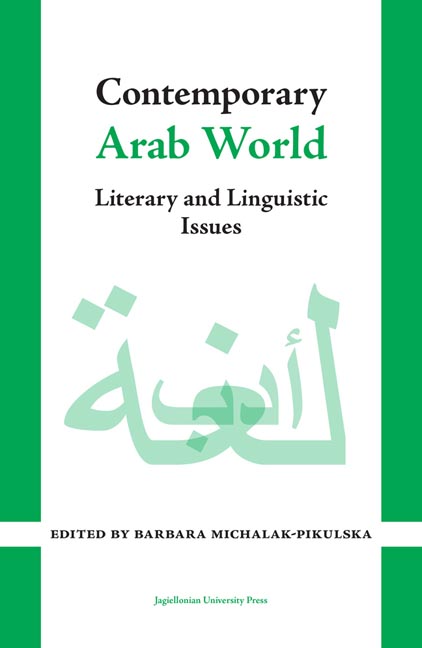Book contents
- Frontmatter
- Contents
- Introduction
- Between past achievements and future challenges Arabic language teaching at the university level – example of the Department of Arabic Studies at the Jagiellonian University in Cracow
- Meanings and functions of genitive constructions in Modern Standard Arabic
- Sultan Qaboos – image of the ruler in panegyrics and elegies by Omani poets
- Microfiction, flash fiction or very short story in modern Arabic literature
- In the maze of discourses – monodrama Bāy bāy Ğīllū (Bye Bye Gillo) by Ṭaha ‘Adnān
- Women in Islamic State propaganda
- Annex
Microfiction, flash fiction or very short story in modern Arabic literature
Published online by Cambridge University Press: 14 October 2023
- Frontmatter
- Contents
- Introduction
- Between past achievements and future challenges Arabic language teaching at the university level – example of the Department of Arabic Studies at the Jagiellonian University in Cracow
- Meanings and functions of genitive constructions in Modern Standard Arabic
- Sultan Qaboos – image of the ruler in panegyrics and elegies by Omani poets
- Microfiction, flash fiction or very short story in modern Arabic literature
- In the maze of discourses – monodrama Bāy bāy Ğīllū (Bye Bye Gillo) by Ṭaha ‘Adnān
- Women in Islamic State propaganda
- Annex
Summary
In the beginning of the 20th century, Arabic prose developed significantly, after moving away from the traditional writing patterns full of contrived rhymes and unnecessary structural decoration, which appears at the expense of meaning. The new literary genres differed and diversified, and as a result the traits of modern narrative forms became clear, especially the novel that began to acquire characteristics that distinguished it from the traditional story. The forms of story varied from long to medium, and from novella to a short story. A new type was formed in Arabic literature, defined with many names, the most prominent of which is “very short story”, or flash fiction, usually between 100 to 1000 words in length.
Polish scholar Mariusz M. Leś took up this literary genre and its great spread in the digital age, although he mentions that critics ignore it: “Microfiction has many names. Basically, it is a very short narrative prose, very popular in the ‘digital age’, but mostly disrespected by critics”.1 The American expert on short stories, Catherine Sustana, enumerates the names of this type of prose as follows: “Flash fiction goes by many names, including microfiction, microstories, short-shorts, short short stories, very short stories, sudden fiction, postcard fiction, and nanofiction”.
Since the 1970s, this narrative genre has begun to take a notable place in Arabic prose, which has been recognized by numerous critics and writers. However, as the Iraqi critic Bāsim ‘Abd al-Ḥamīd Ḥammūdī asserts, the harbingers of the very short story in the Arab world occurred in 1930, when lawyer Nū’īl Rassām published his first stories, which represented the true beginning of this fictional art in Iraq.3 A few years before that, the short story had emerged, about which the well-known Egyptian critic, Yūsuf ash-Shārūnī, said: “It is not possible to define one origin for it, because each era has its own narration, and every narrator has his own narration indeed…”4
The era of microfiction stories began to be a fact in the east of the Arab world and then reached the Maghreb countries. At the end of the 20th century and at the beginning of the 21st century, the authors of this type of prose, formed a large group of creators.
- Type
- Chapter
- Information
- Contemporary Arab WorldLiterary and Linguistic Issues, pp. 85 - 106Publisher: Jagiellonian University PressPrint publication year: 2020

